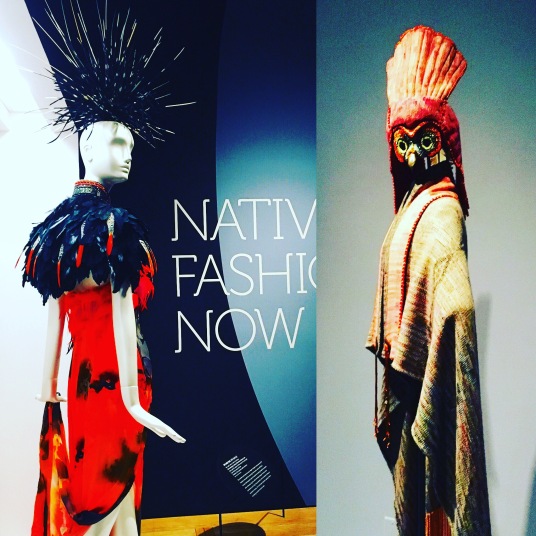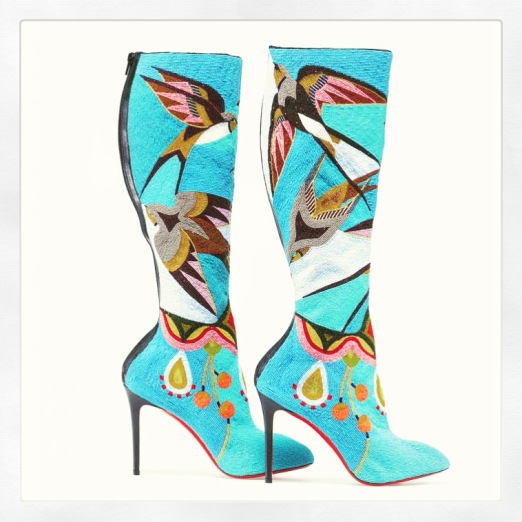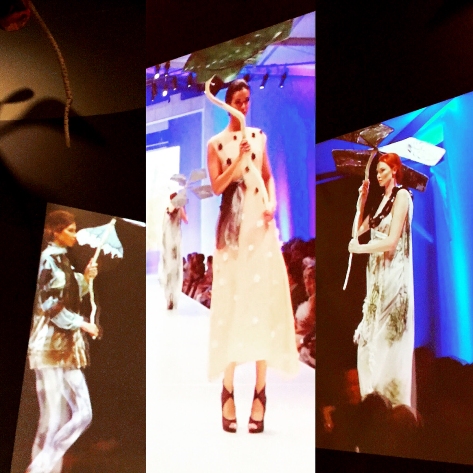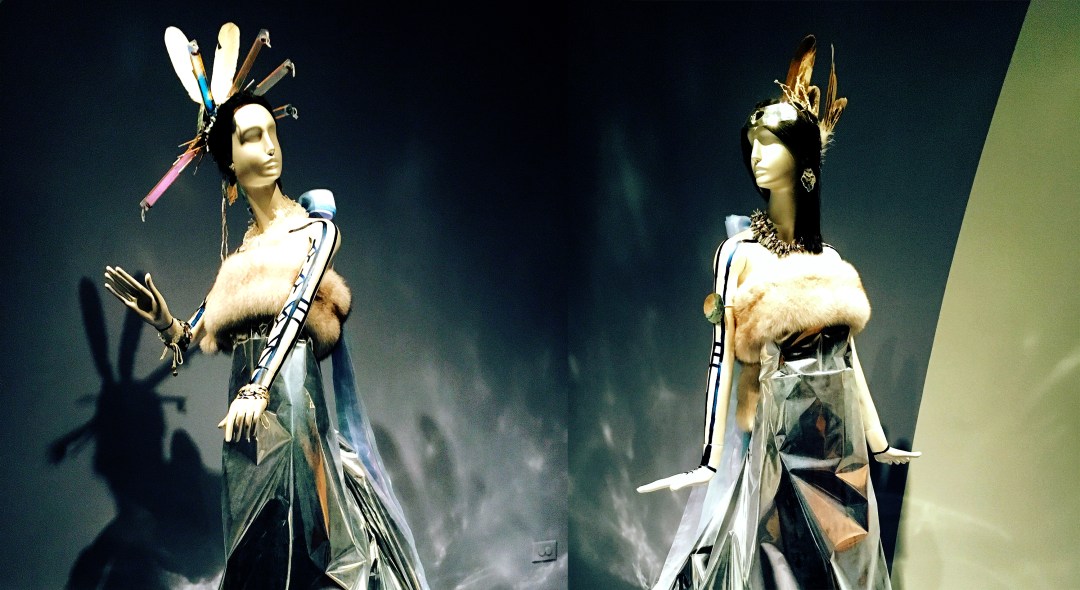Within the echo chamber of popular culture, the dominant perception of Native Americans is outdated. Their marginalization is part of a larger phenomenon, where entire ethnic groups are often distilled into one-dimensional narratives. When it comes to Indigenous Americans, the mental image that most people conjure up is as static and unchanging as the sepia-toned photographs of 19th century Plains Warriors.

As a remedy to this antiquated historical reference, curator Karen Kramer conceived of an exhibition that would facilitate an “expansive and inclusive definition of Native fashion that includes street wear and cutting-edge haute couture.” With Dr. Jessica Metcalfe of Beyond Buckskin as one of her advisors, Kramer curated “Native Fashion Now,” which debuted at the Peabody Essex Museum in Salem, MA in 2015. The show is currently on display at the Smithsonian National Museum of the American Indian in New York City, and features the works of “nearly 70 living contemporary Native artists.”

When Kramer began conceptualizing “Native Fashion Now,” it was with the intention to create a space “for Native designers to define for themselves what Native fashion is and can be.” By displaying contemporary works, Kramer has shed light on how Indigenous Americans are constantly evolving, despite still being viewed through the lens of the colonial settlers. Just as Columbus era Native Americans developed techniques for working with the colorful Venetian beads that they acquired through trade, the skills of their descendants have also evolved to reflect the latest innovations. In Wendy Ponca’s dresses (header image) that are inspired by the “Sky World,” she blends fox fur and bald eagle feathers with crystals and Mylar, a reflective silver material found in space shuttles. Through these cutting-edge designs, “Native Fashion Now” encourages the audience to confront their preconceived notions, while shifting the narrative voice back to where it should have been all along, from the perspective of Native Americans themselves.
The exhibition is organized according to a thematic structure, as a way of articulating the depth and complexity involved in the works. The four themes are Revisitors, Pathbreakers, Provocateurs, and Activators. In the Revisitors section, designers expand upon “traditional cultural motifs,” which is exemplified by the high heel Louboutin’s that were hand beaded by Jamie Okuma (Luiseño/Shoshone-Bannock).

These boots are the closest representation of a self-portrait that Okuma has ever created. The embroidery style beadwork depicts an elaborate mosaic of swallows, which Okuma and her family rescued and then raised on the La Jolla Reservation. The boots marry Okuma’s love of high fashion with childhood reveries and traditional beadwork. Okuma’s path to becoming a multi-media artist and designer is rooted in the tradition of pow wow. Adornment was an integral part of the ceremony, and so she learned to make her outfits by observing her mother. What began as a means to participate, quickly developed into a lifelong passion for art and design.

There are also some non-Native designers included in Revisitors, such as Isaac Mizrahi and Ralph Lauren, which is Kramer’s way of acknowledging the influence of Native culture on the fashion industry at large. Since designers are perpetually on the hunt for inspiration, appropriation of Native adornment is a recurring issue. On the one hand, this means that there is a desire for their unique style, but when Indigenous Americans have to compete with inexpensive knockoffs, they are not actually reaping the rewards. And when the word “Native” is used as a description, not only is it confusing to the customer, but the appropriated works end up perpetuating the stereotypes that created them in the first place. In an article for the Beyond Buckskin blog, Metcalfe writes
“GO TO THE SOURCE. We can start taking an active stance to support Native designers, especially in our own day-to-day wardrobes, and help re-kindle the ancient legacy of Native adornment and reverse the assimilation assault of the past. It is now the easiest than it has ever been in the past one hundred years to buy or acquire clothing, jewelry and accessories made by Native American fashion designers. Many of these designers are connected to their communities, and are keenly aware of what sacred symbols and items should not be for sale to outsiders. Instead they look within themselves and draw inspiration from their backgrounds and experiences.” – Dr. Jessica Metcalfe
For Native designers who look beyond their cultures for inspiration, Pathbreakers are the artists that have ventured into new territory to create groundbreaking designs. This is where the earliest works are found, dresses from the nineteen sixties by the “father of contemporary Native fashion,” Lloyd Kiva New (Cherokee). Fans of Project Runway might recognize the leather “Cityscape” dress by Taos Pueblo designer Patricia Michaels, from when she was a contestant on the 11th season.

The dress was created during the very first challenge, when she was asked to design a garment that represented her aesthetic, while also incorporating her vision of Manhattan, as seen from a ferry. Noticing the rigid lines and geometry from a distance, Michaels was inspired by the skyscraper paintings of Georgia O’Keefe and the minimalist style of Agnes Martin, both painters who “found their hearts and souls in Taos Pueblo.” Michaels credits the experience with her current success, and her trailblazing spirit is also apparent in the way she runs her eco-friendly clothing line, PM Waterlily (slideshow is of her latest collection).
Realizing that clothing production could be a source of income, not just for her, but for her local community, Michaels developed a cottage industry. And as her business continues to evolve, she has plans to incorporate a vegetable garden into her work environment. Her goal is to create an atmosphere that is productive, but also nourishing, where her artisans will have access to organic food.
“We’ve always taught that Mother Earth heals and…I want my employees to have that…[We have] become so industrial that we’ve lost a lot of our upbringing and our traditions and culture, and one of them is farming.”
– Patricia Michaels
Michaels also frequently collaborates with her son, filmmaker Gabriel Mozart Steven Abeyta, and his video of her runway show accompanies her work in the exhibition.

While the film industry bears a lot of responsibility in perpetuating stereotypes, Abeyta recognizes the potential of the medium to disrupt those misconceptions. He is in the process of fundraising for his first feature length film, “Beginnings of My Heart,” which was developed through Sundance’s IAIA writers workshop.
Kristen Dorsey is a jewelry designer who is featured in the Provocateur part of the exhibition. She is also a member of the Chickasaw Nation, a Southeastern tribe that was displaced from its homelands in Mississippi, Tennessee, and Alabama. Dorsey is often confronted with the misguided expectation that all Native jewelry should be made of turquoise and silver. Dorsey explains Chickasaw tradition as having “strong roots in adornment as a form of identity,” and significance is often ascribed to the materials used, which include copper, shells, and pearls. Dorsey’s collections share a thematic symmetry with the pre-colonial Mississippian culture of her tribe. The tradition revolves around the mythological beings that inhabit three worlds – The Sky World, The Earth, and The Underworld. Dorsey’s contributions to “Native Fashion Now” come from her “Shockmalli” collection, which means lightning. Her “Stingray” breastplate was inspired by the Sky Serpent, a deity from her tribe’s mythology.

“Fluidity and grace, light and shadow, keeper of the secrets of the stars, she controls the movements of celestial bodies. The wind is her breath, she is the ancient one…Giver of life, taker of life, seductive as the twinkle of starlight in the darkened night.”
As an artist, Dorsey seeks to provoke thought and conversation. She considers the environmental effects of fine jewelry production and gemstone mining, and has donated proceeds from some of her sales to the water protectors at Standing Rock. She also deals with the issue of “Blood Quantum,” which are a series of laws that were designed to quantify one’s Native identity. Not included in the exhibition, but listed on her website, is a piece called “Blood Bling.”

“Blood Bling comments on the…Government Issued Certificate of Degree of Indian Blood Cards…The concept of ‘blood quantum’ is a European creation and did not exist in Indigenous communities. It is based on the racist notion that culture follows blood and that the European blood/culture is stronger and that the Native blood/culture, therefore the ‘Native blood’ would ‘breed out’. This tool of colonization remains steadfast in contemporary American culture and negatively affects Indigenous peoples who must apply for their CDIB cards from the American government in order to prove their cultural identities.”
– Kristen Dorsey

The fourth theme in the exhibition is called Activators, and these artists juxtapose personal style with political statements. Jared Yazzie’s (Dine [Navajo]) graphic tee is simple, and yet the message effectively challenges the dominant narrative.

The phrase “Native Americans Discovered Columbus” is printed in bold, block letters. Also included in this section are the Spirit Wolf Chucks by Louie Gong (Nooksack/Squamish). Gong’s work blends Native culture with urban influences and his company is called Eighth Generation. Gong’s explanation of the name is a gateway into understanding why Indigenous American culture is inherently sustainable. Seven Generation Stewardship stems from the belief that the earth “does not belong to us.” (Chief Seattle)
“The name ‘Eighth Generation’ references the inter-tribal value of “Seven Generations,” which suggests that we consider the impact of our decisions on the next seven generations. By naming my business Eighth Generation, I embed respect for the previous generations all my work and recognize that my successes are a result of our collective effort.”
– Louie Gong, from his website
During the talk that Karen Kramer gave at the Smithsonian National Museum of the American Indian on February 16th, the curator reflected on the origins of the exhibition. She explained that a few years ago, an internet search of Native American Fashion, yielded an overwhelming number of “images of 19th century Plains Warriors.” Now that “Native Fashion Now” has traveled from the Peabody Essex Museum to the Portland Art Museum and the Philbrook Museum of Art, Kramer decided to try the search again. The same internet query now results in “tons of images of Native fashion, Native style, Native design, by Native artists.”
And while the medium of the exhibition is fashion and adornment, the brilliance of its execution is that we now have a genuine representation of Indigenous American culture in public space. The exhibition is currently on display at the Smithsonian National Museum of the American Indian in lower Manhattan.
To learn more about Jamie Okuma, Kristen Dorsey, and Patricia Michaels, listen to my interviews with the designers on “Haute-Mind Radio” (on the left side of the webpage). The interviews originally aired during the “Arts & Answers” segment on WKCR.
Writer / Guest Host : Ashley Rabin
Radio Producer : Katherine Cohn
Sound Editor : Aaron Leeder

Fabulous pictures…and info too….thanks….you do touch me with your abilities……Keep growing and sharing….Love—Joe
LikeLike